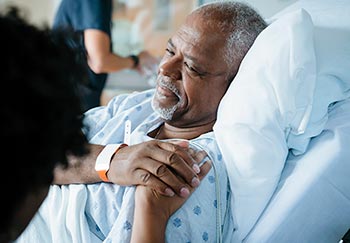
There’s a lot more to your blood than meets the eye, especially if you’re over 50. Blood (hematologic) cancer is a broad term used to describe cancers of the blood.
Blood contains red blood cells that carry oxygen from your lungs, white blood cells to fight infection, and platelets to clot blood when necessary. Plasma is the liquid component of blood and all blood cells are made in the bone marrow.
What Cancers Does It Cover?
There are three main types of blood cancer:
- Leukemia is cancer of the blood cells in which the bone marrow produces large numbers of abnormal white blood cells. The abnormal white blood cells aren’t able to fight infection and they eventually outnumber healthy blood cells.
- Lymphoma is a blood cancer that involves infection-fighting white blood cells. Irregular lymphocytes become lymphoma cells, which start to multiply and amass in your lymph nodes wreaking havoc in your immune system over time.
- Myeloma is a cancer where the growth of abnormal plasma cells leads to cancer in the bone marrow.
Who Gets Blood Cancer?
More than 170,000 Americans will be diagnosed with a form of blood cancer this year. That means blood cancer will account for about 10% of all new cancer cases diagnosed in the U.S. Most people diagnosed with leukemia are over 50.
Leukemia
Risk factors for leukemia include being age 60 or older, receiving chemotherapy or radiation therapy for a previous cancer, and chronic exposure to benzene or tobacco smoke. If you’re around that age and you smoke, it’s time to quit.
Leukemia symptoms include fevers and/or night sweats, prolonged flu-like symptoms, tiny red spots under your skin, and excessive bruising or bleeding. This includes nosebleeds.
Lymphoma
Lymphomas are divided into two groups: Hodgkin and non-Hodgkin. There are more than 30 sub types of non-Hodgkin lymphoma. Getting older doesn’t help, as most cases occur in people in their 60s or older. As with leukemia, exposure to benzene, radiation, and prior chemotherapy are risk factors. If you have a weakened immune system you want to be extra diligent about your risk for lymphoma.
Lymphoma symptoms can be similar to those of leukemia and include enlarged lymph nodes, fevers, unexplained weight loss, night sweats, and extreme fatigue. Other possible symptoms include swollen abdomen, feeling full after only a small amount of food, chest pain or pressure, and shortness of breath or cough.
Multiple Myeloma
Most people diagnosed with myeloma are at least 65 years old and it’s more common among men. Multiple myeloma often causes no symptoms until it reaches an advanced stage. Symptoms include bone pain and fractures, anemia, excessive bleeding, kidney damage, numbness, and muscle weakness.
Many blood cancer symptoms mimic those of benign conditions. The best way to protect yourself is through regular doctor visits and maintaining your health with proper diet and exercise as you get older.

